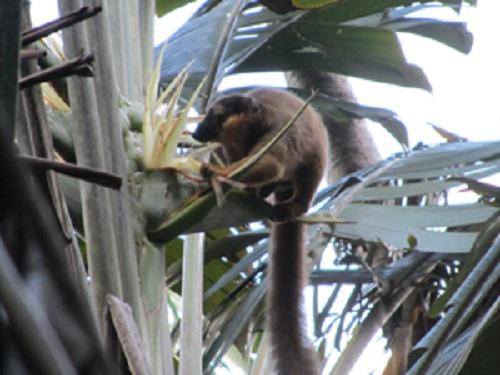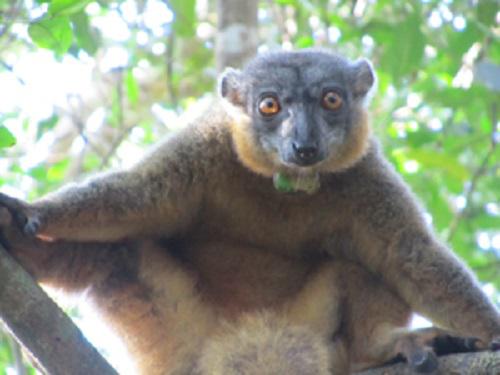The aim of the project is to understand whether lemur populations living in partially degraded forests undergo nutritional and/or social stress when compared to populations occurring in intact habitats.

Male of Eulemur collaris feeding on Ravenala flowers.
The littoral forest of south-eastern Madagascar is today represented by an archipelago of small, degraded fragments. The largest lemur species occurring in this habitat, the collared lemur (Eulemur collaris), survives in three forest fragments. In 2000, a small population of collared lemurs was relocated from a forest destroyed by human activities into a conservation area. However, there was virtually no intact habitat left in the area and the protected forest fragment was partially degraded as well.

Eulemur collaris, female.
Previous research has shown that the lemur population has established in the new area by modifying group structure, ranging pattern and diet. Nevertheless, a population decline was recently observed. The reasons for this drop are still obscure. In particular, it is not clear whether these animals suffered from nutritional, demographic or predation problems compared to lemurs living in intact habitats. The goal of this project is to investigate in detail the link between nutritional ecology, social structure, and stress levels in the relocated lemur population. In order to answer these questions, we will use the population of collared lemurs in Mandena as a case, comparing it with a control living in an intact littoral forest (Sainte Luce). In particular we want to:
- Assess the present population size and structure in Mandena and in Ste Luce.
- Identify possible differences in food intake and diet quality among sites, seasons, sexes and ranks.
- Identify possible differences in social structure between sites.
- Identify possible differences in frequencies of anti-predator behaviours between sites.
- Identify possible differences in activity regime and behavioural thermoregulation linked to group size and edge effect of the forest.
- Compare faecal glucocorticoid content among sites, seasons, sexes and ranks. These data will be used as indicator of stress and related to the ecological/social variables described above.
Most animal relocations, including those involving primates, did not follow a long-term monitoring agenda. Post-release monitoring is considered by IUCN a crucial part of any translocation or re-introduction project. This study offers the opportunity for a longitudinal data gathering on potentials and pitfalls of medium-sized lemur relocations between forest fragments. Furthermore, we have the possibility to record in the long-term the demographic, ecological and social consequences of lemur tolerance to degraded habitats. This is of critical importance, since the survival of many forest species largely depends on their ability to cope with environments modified by human activities and/or by climate change.